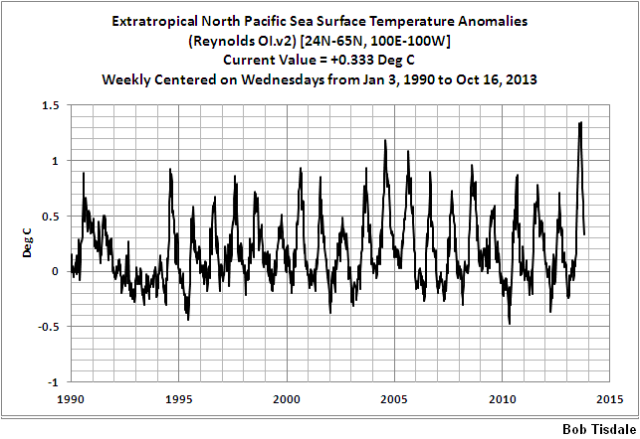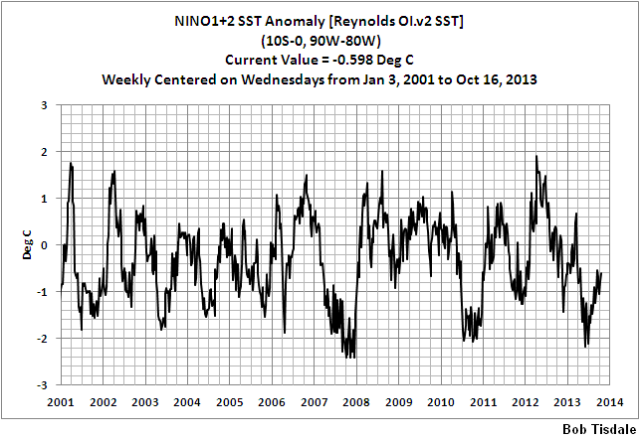The unusual warming event in extratropical North Pacific peaked a number of weeks ago and sea surface temperatures there continue to fall. We’ll just have to wait to see where they bottom out during the seasonal cycle in the North Pacific anomaly data.
Weekly Extratropical North Pacific
# # #
Global sea surface temperature anomalies are at about +0.22 deg C for the week centered on October 16th, compared to the base years of 1971-2000. They were driven upwards this summer by the North Pacific. They too are falling.
Weekly Global
# # #
The sea surface temperature anomalies of the NINO3.4 region in the equatorial Pacific (5S-5N, 170W-120W) are a commonly used metric for the frequency, strength and duration of El Niño and La Niña events. For the week centered on Wednesday October 16, 2013, they were at about -0.31 deg C, below zero but not into La Niña conditions. La Niña conditions are generally considered to occur when sea surface temperatures in the NINO3.4 region are cooler than -0.5 deg C.
Weekly NINO3.4
# # #
Sea surface temperatures in the eastern equatorial Pacific are still quite cool, as they have been for most of this year. They have once again warmed in recent weeks. The NINO1+2 region is bordered by the coordinates of 10S-0, 90W-80W, and its sea surface temperature anomalies are approximately -0.60 deg C.
Weekly NINO1+2
INTERESTED IN LEARNING MORE ABOUT THE EL NIÑO AND LA NIÑA AND THEIR LONG-TERM EFFECTS ON GLOBAL SEA SURFACE TEMPERATURES?
Why should you be interested? Sea surface temperature records indicate El Niño and La Niña events are responsible for the warming of global sea surface temperature anomalies over the past 30 years, not manmade greenhouse gases. I’ve searched sea surface temperature records for more than 5 years now, and I’ve searched ocean heat content records for more than 4 years, and I can find no evidence of an anthropogenic greenhouse gas signal. That is, the data indicates the warming of the global oceans has been caused by Mother Nature, not anthropogenic greenhouse gases.
For a further discussion, see the essay (pdf) titled The Manmade Global Warming Challenge. (It’s 42MB, but it’s free and worth the download time.)
Last year, I published my e-book (pdf) about the phenomena called El Niño and La Niña. It’s titled Who Turned on the Heat? with the subtitle The Unsuspected Global Warming Culprit, El Niño Southern Oscillation. It is intended for persons (with or without technical backgrounds) interested in learning about El Niño and La Niña events and in understanding the natural causes of the warming of our global oceans for the past 30 years. Because land surface air temperatures simply exaggerate the natural warming of the global oceans over annual and multidecadal time periods, the vast majority of the warming taking place on land is natural as well. The book is the product of years of research of the satellite-era sea surface temperature data that’s available to the public via the internet. It presents how the data accounts for its warming—and there are no indications the warming was caused by manmade greenhouse gases. None at all.
Who Turned on the Heat? was introduced in the blog post Everything You Ever Wanted to Know about El Niño and La Niña… …Well Just about Everything. The Updated Free Preview includes the Table of Contents; the Introduction; the beginning of Section 1, with the cartoon-like illustrations; the discussion About the Cover; and the Closing. The book was updated recently to correct a few typos.
Please buy a copy. (Credit/Debit Card through PayPal. You do NOT need to open a PayPal account.) Simply scroll down to the “Don’t Have a PayPal Account” purchase option. It’s only US$8.00.
VIDEOS
For those who’d like a more detailed preview of Who Turned on the Heat?, see Parts 1 and 2 of the video series The Natural Warming of the Global Oceans.
SOURCES
The Sea Surface Temperature anomaly data used in this post is available through the NOAA NOMADS website:
http://nomad1.ncep.noaa.gov/cgi-bin/pdisp_sst.sh
or:






